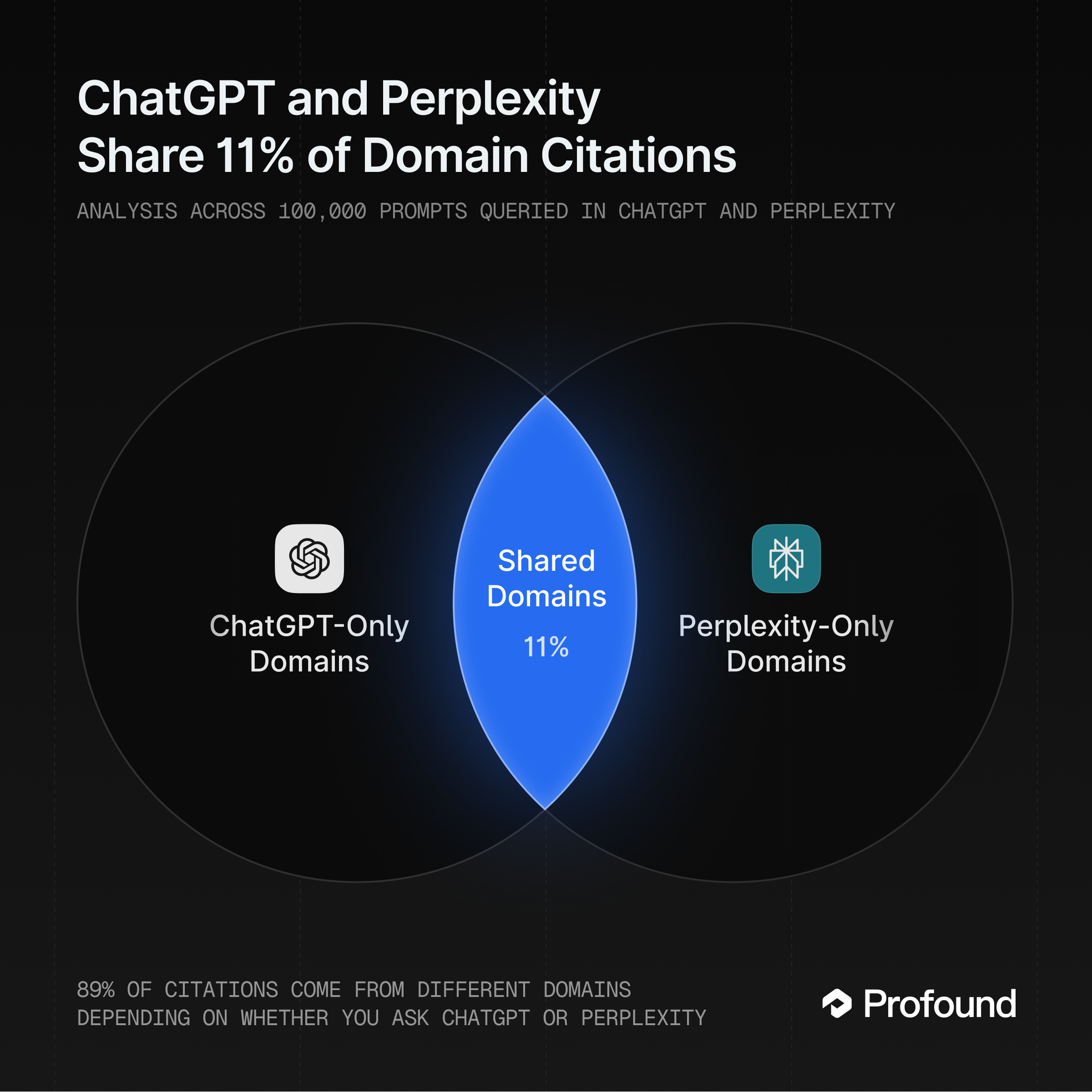The era of one-size-fits-all content strategy is over. AI models are carving up the internet in dramatically different ways by citing different domains for the same prompts. Understanding citation overlap patterns has become the secret weapon for maximum visibility.
The Shocking Truth: AI Models Don't Share Sources
Our analysis of 100,000 distinct prompts run across both ChatGPT and Perplexity revealed a surprising truth: these models are citing fundamentally different corners of the internet.

This means nearly 89% of AI citations come from completely different sources depending on which model users query. You could be visible in one model but completely invisible in another, and you'd never know without monitoring your visibility across all platforms.
This fragmentation pattern holds across all AI models. Our broader analysis shows overlap rates ranging from just 6% (Google AI Overviews vs Microsoft Copilot) to 16.4% (Perplexity vs Google AI Overviews).
Citation Volume Varies Dramatically by Platform
The sheer number of sources each AI model references tells us something important about citation opportunities:
This volume difference has massive implications for your visibility strategy. High-citation models like Google AI Overviews and Perplexity offer more citation slots per query, meaning more opportunities for your content to be referenced.
ChatGPT only cites 5 domains on average per response, meaning you have 50% fewer chances to be included in an answer compared to page 1 of Google.
But Volume Doesn't Equal Overlap
Despite some models citing 3x more sources than others, the overlap patterns reveal the real story. Nearly 90% of AI citations come from completely different sources depending on which model users query, regardless of how many total sources they cite.
We're witnessing the birth of multiple "internet realities:" each AI model presenting its own version of what information matters most.
Our Recommendation: Target the Overlap First
That 11% overlap is your highest-value real estate on the internet. These overlapping citation sources represent the rare domains that multiple AI models trust and reference consistently.
Why overlap matters:
- Maximum reach across different AI user bases
- Higher likelihood of citation regardless of which AI someone uses
- Better ROI on content creation efforts
- Built-in redundancy for your visibility strategy
Universal Heavy-Hitters (High Overlap):
- Reddit and similar community platforms
- Major news outlets and authoritative sources like Forbes and G2
- Wikipedia and educational resources
Think of overlap sources as your "citation insurance policy." They're the closest thing to guaranteed AI visibility you can get.
But Sometimes Overlap Isn't Enough
While overlap sources should form your foundation, platform-specific strategies can give you a competitive edge:
- Platform-Specific Opportunities
- Perplexity prioritizes YouTube and LinkedIn
- ChatGPT cites TechRadar and BusinessInsider often
- Google AI Overviews leans on Quora and Gartner
Your Citation Overlap Strategy
Phase 1: Secure the Overlap
Start with sources that appear in multiple AI citation pools (using a tool like Profound to pull this data initially). These platforms offer the highest probability of cross-platform visibility and should receive your primary content investment.
Phase 2: Know Your Audience's AI Preferences
Research which AI platforms your target audience actually uses, but also consider citation volume in your strategy:
High-Volume Domain Citation Platforms (7+ sources per response)
- Google AI Overviews and Perplexity offer more citation opportunities per query
- Higher chance of multiple citations from your brand in a single response
- Better for brands with content across multiple domains/platforms
Lower-Volume Domain Citation Platforms (2-5 sources per response)
- ChatGPT and Copilot are more selective with citations
- Each citation carries more weight and visibility
- Requires higher content quality and authority to earn citations
Phase 3: Monitor and Adapt
Citation patterns evolve as AI models update their training data and algorithms. Regular analysis of citation overlap helps you stay ahead of these shifts.
The Fragmented Future of AI Search
This fragmentation creates both challenges and opportunities:
The Challenge: Your content might be invisible to entire segments of AI users if you're not on their platform's preferred sources.
The Opportunity: Understanding these patterns gives you a massive competitive advantage over brands still using outdated, one-size-fits-all content strategies.
Action Items for Maximum AI Visibility
- Audit your current presence across high-overlap citation sources
- Identify which AI platforms your audience uses most frequently
- Prioritize content creation for overlap sources first, platform-specific sources second
- Track citation patterns quarterly to catch emerging trends
- Test and measure your visibility across different AI platforms
The Bottom Line
Citation overlap analysis is becoming table stakes for all brands who care about how they show up in AI search. Understanding these citation patterns is the difference between being found and being forgotten.
The brands that master citation overlap strategy today will own tomorrow's AI-driven search landscape. The question isn't whether you should adapt to this new reality; it's whether you'll do it before or after your competitors.
Want to see which models you show up in the most, and which models you're invisible on? Get a demo of Profound and receive a custom report analyzing your brand's presence across AI platforms.
